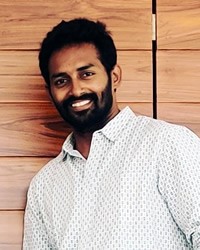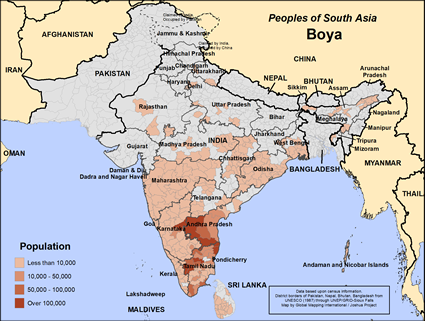Boya in India

Photo Source:
Anonymous
|

Map Source:
People Group Location: Omid. Other geography / data: GMI. Map Design: Joshua Project
|
| People Name: | Boya |
| Country: | India |
| 10/40 Window: | Yes |
| Population: | 4,049,000 |
| World Population: | 4,067,000 |
| Primary Language: | Telugu |
| Primary Religion: | Hinduism |
| Christian Adherents: | 0.00 % |
| Evangelicals: | 0.00 % |
| Scripture: | Complete Bible |
| Ministry Resources: | Yes |
| Jesus Film: | Yes |
| Audio Recordings: | Yes |
| People Cluster: | South Asia Hindu - other |
| Affinity Bloc: | South Asian Peoples |
| Progress Level: |
|
Introduction / History
The Boya can be found throughout Andhra Pradesh. However, they are found mainly in the Kurnool, Anantapur and Guntur districts. They speak Telugu and use Telugu script for writing. They are called 'Boya' in Andhra Pradesh, 'Boyar' in Tamil nadu and 'Bhovi' in Karnataka. Boya, Boyar, Boyi, Bhovi are the hereditary and clan titles. Boyar caste consists of many gotras.
The Boya are considered one of the oldest castes and origin among many castes in India. The Boyars migrated from Indo-Iran around 5th century BC to Indian sub-continent and later 9th century to Turkey, Ireland and Romania. Boyars have Dravidian roots came from Indus Valley invaded south region. Boyars are mainly found in South India as Hindu Telugu speaking community and non-pure kshatriyas. The Boyar arrived in Andhra - Odisha region during Indo-Aryan migration around 5th century BC. Boyar warriors served as military regiment between 10th century to 15th century in Chalukya, Chola, Vijayanagar and Hoysala empires.
The Musunuri Nayaks were Boyars and Kamma warrior chieftains in the Kakatiya army, who regained Andhra in 1326 from the Delhi Sultanate in the aftermath of the Kakatiya defeat. King Pratapa Rudras Kakatiya kingdom was served by seventy five chieftains called Nayaks. The Nayaks who belonged to various agrarian castes such as Boyar, Velama, Kamma, Reddy, Telaga, Balija, etc. were divided by mutual jealousy and rivalry but they are valiant cousins. Later in 17th century Boyars distinguished themselves as smiths, sculptors, nobles, leaders, priests, landlords, temple sculptors, arm traders and sea farers.
What Are Their Lives Like?
Rice, ragi and jowar are their stable cereals. Agriculture is their main occupation. They also work as laborers on an annual wage basis. Only a small number are employed in government offices. Child labor is prevalent.
They live in nuclear families and follow patrilocal residence. Marriages are arranged by parents and dowry is a popular practice. A divorced man can remarry but a divorced woman is not allowed to remarry. Cross-cousin and maternal uncle-nice marriages have preference.
Unlike most Hindu communities, the Boya bury their dead.
What Are Their Beliefs?
They worship gods such as Malavobulesu, Chettu Devara and Mabbu Devara.
On special occasions young boys perform a folk dance called Kilata or Kolanna. New clothes are offered during the Ugadi and Sankranti festivals as a form ancestor worship. They work as laborers who set up pandals and carry lights on festive occasion.
What Are Their Needs?
Like all other peoples of the world, this people group needs the blessings and guidance that only Jesus Christ can offer.
Prayer Points
For the salvation of entire Boya families. May they take the name of Christ to other families.
Pray for various developmental programs to improve their lives.
Pray for loving workers to go to the Boya people.